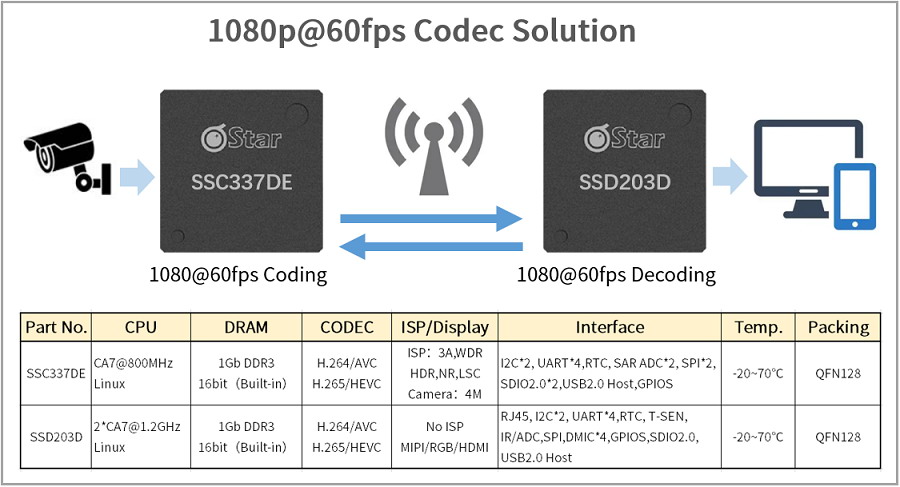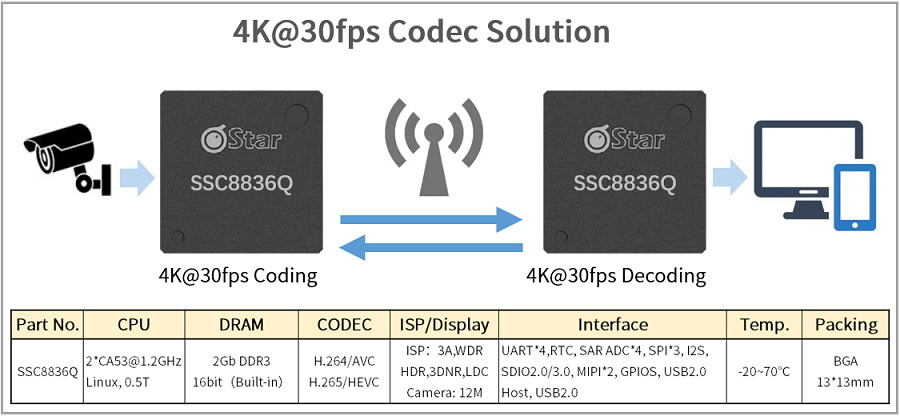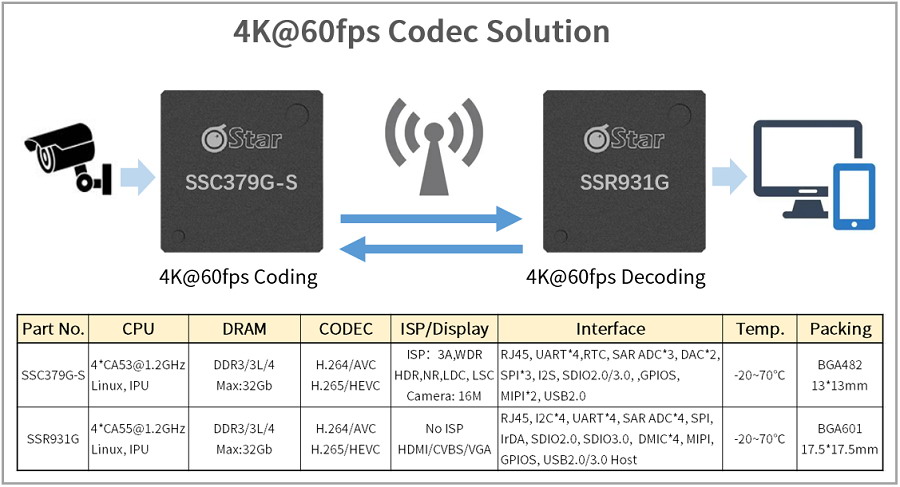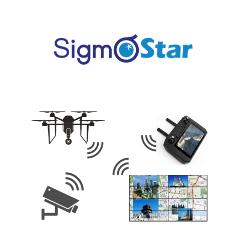I. Introduction to Image Transmission Technology
Image transmission refers to the technology of transferring images or media content from one device to another. The transmission media can be radio waves, optical fibers, Ethernet, etc. An image transmission system mainly consists of an image acquisition device, a transmission device, and a receiving device. The image acquisition device is responsible for capturing real - time images. The transmission device converts the captured images into data streams and sends them to the receiving device via the transmission medium. The receiving device receives and decodes the data streams and displays the images. Currently, image transmission systems are widely used in fields such as security monitoring, consumer electronics, medical equipment, drones, robots, and inspection.
(1) Image Acquisition: CMOS/CCD image sensors are used to capture images. These sensors can convert light signals into electrical signals, and then an AD converter converts the electrical image signals into digital signals.
(2) Encoding and Compression: To reduce the amount of image data for transmission, the image data needs to be compressed. Commonly used compression encoding algorithms include JPEG, H.264, and H.265. Taking the common H.264 as an example, with the YUV420 format, the bit - rate of 640x480@15fps is approximately 55.296Mbps. After H.264 encoding, the bit - rate drops to 500Kbps, which means the compression rate of H.264 reaches about 1%.
(3) Signal Transmission: Digital communication technologies are used to transmit the compressed bit - stream to the receiving end. Commonly used transmission technologies include wired Ethernet and wireless technologies such as WiFi, cellular networks, and Bluetooth.
(4) Decoding and Display: After receiving the transmitted bit - stream, the receiving end first needs to decode it, and then converts the decoded data into analog image signals through a DAC for display on the screen.
1.1 Classification of Image Transmission
(1) Analog Image Transmission: This is an early solution that converts images into analog signals for transmission. It is characterized by a simple design but has weak anti - interference ability and poor transmission quality. Therefore, it is used in low - cost scenarios where the image quality requirements are not high.
(2) Digital Image Transmission: This is the most widely used image transmission solution at present. By converting images into digital signals for transmission, it can achieve higher - quality image transmission. Digital image transmission features good stability, strong anti - interference ability, and long transmission distance, but there may be some transmission delay. Currently, high - definition image transmission usually adopts 1080p, and high - end products can achieve 4K ultra - high - definition resolution.
1.2 Wireless Image Transmission
Wireless image transmission technology is a fixed - point wireless image monitoring and transmission system, mainly used in scenarios where wired closed - circuit monitoring is difficult to implement. From the application perspective, it can be divided into two major categories: fixed - point image monitoring and transmission systems and mobile video image transmission systems.
(1) Multiple image transmission technologies in the 2.4GHz ISM band: The throughput rate is about 2Mbit/s. If frequency - hopping technology is used, the anti - interference ability is relatively strong.
(2) 3.5GHz band wireless access system: It is a point - to - multipoint microwave communication technology. The transmission distance usually reaches 5 - 10 km, and the transmission bandwidth is usually 30MHz for both uplink and downlink.
(3) 5.8GHz WLAN products: WLAN products in this band are based on the IEEE802.11a protocol. The transmission rate can reach 54Mbit/s, and they can transmit digital high - definition images, which are suitable for urban security monitoring systems.
(4) 26GHz band broadband fixed wireless access system: It can meet the requirements of high - speed broadband data, image communication, and broadband Internet services. The coverage range is 3 - 5 km, and it is suitable for metropolitan area networks.
(5) Image transmission via cellular communication systems: It uses 4G and 5G cellular communication networks, which can provide a wide coverage area and high - speed data transmission capabilities.
(6) Satellite communication transmission: It can be widely used in long - distance and remote - area drone communication.
1.3 Advantages and Disadvantages of Analog Wireless Image Transmission
(1) Advantages: Low cost.
(2) Multiple receivers can receive video signals simultaneously, facilitating multi - person viewing.
(3) Different antennas can be paired to achieve different reception effects.
(4) The working distance in open areas is over 2 km.
(5) There is basically no delay in the video signal, which is essential for low - altitude high - speed flight.
(6) Disadvantages: Small video bandwidth. The image resolution is usually only 640*480. Analog signal transmission is easily interfered with. Receivers without DVR (video recording) function cannot review videos.
1.4 Advantages and Disadvantages of Digital Wireless Image Transmission
(1) Advantages: Easy to use. Usually, a mobile phone/tablet computer can be installed on the remote controller as a display.
(2) The image transmission resolution of mid - to - high - end products can reach 1080p or even 4K.
(3) The transmission distance can also reach over 2 km.
(4) It is more convenient to review the captured photos and videos in real - time.
(5) Disadvantages: The system price is relatively high. The delay of digital image transmission may be greater than that of analog image transmission.
Overall, since the video quality and stability of digital image transmission are far better than those of analog image transmission systems, it is suitable for users with high image - quality requirements. Therefore, digital image transmission is usually used in industrial - level applications. On the other hand, analog image transmission, with its low cost and low delay, is suitable for users with limited budgets or special requirements for flight control.
II. Sigmastar's Image Transmission Encoding/Decoding Solutions and Chips
SigmaStar has core teams in chip design, algorithms, global marketing, and supply chain. It has advantages in ISP, audio and video encoding/decoding, analog circuit design, SoC system design, and self - developed IPs. The team focuses on chip R & D in fields such as security, intelligent assisted driving, the Internet of Things, and smart homes. Its products cover IP Cam, USB Cam, Car Cam, NVR, DVR, action cameras, smart homes, and smart displays.
In the field of image transmission video encoding/decoding applications, Sigmastar's video encoding/decoding chips and solutions can effectively cover from 1080p 30fps to 4K 60fps. Below, we will focus on three solutions: 1080p 60fps, 4K 30fps, and 4K 60fps.
2.1 1080p 60fps Solution: (SSC337DE + SSD203D)
The SSC337DE uses an ARM Cortex A7@800MHz processor and has a built - in 1Gb DDR3. It supports SPI NOR/NAND Flash startup and has a built - in H.264/H.265 encoder. It integrates an AES/DES/3DES/SHA cryptographic engine and supports secure boot, authentication, and encryption of video/audio streams in a secure system. The high - performance ISP (Image Signal Processing) supports 3A (Automatic White Balance, Automatic Exposure, Automatic Focus), WDR (Wide Dynamic Range), HDR (High Dynamic Range), NR (Single - frame Noise Reduction), LSC (Lens Shading Correction), and can be externally connected to a maximum of a 4 - megapixel MIPI or DVP interface image sensor. 

Figure 1: Sigmastar's 1080p 60fps Image Transmission Encoding/Decoding Solution
The SSD203D chip used at the receiving end has a built - in dual - core ARM Cortex A7 with a maximum operating frequency of 1.2GHz. It supports a 2D graphics engine and has a built - in 1Gb of DDR3. It supports H.264/H.265 decoding and MIPI/RGB and HDMI video outputs.
2.2 4K 30fps Solution: (SSC8836Q * 2)
The SSC8836Q uses a dual - core ARM Cortex - A53 processor with a maximum operating frequency of 1.2GHz and an advanced low - voltage and low - power architecture. It has a built - in H.264/H.265 video encoder, which can adapt to more application scenarios. The integrated AES/DES/3DES/SHA cryptographic engine supports secure boot, authentication, and encryption of video/audio streams in a secure system. The high - performance ISP can support a maximum of a 12M (4096x4096) pixel camera and also supports functions such as 3A, WDR, HDR, 3DNR, and LDC (Lens Distortion Correction). 

Figure 2: Sigmastar's 4K 30fps Image Transmission Encoding/Decoding Solution
The SSC8836Q is also used for image decoding at the receiving end, which makes the design and production more convenient. If the decoding and display end needs to output an HDMI signal, the SSC8836Q - H can be selected.
2.3 4K 60fps Solution: (SSC379G - S + SSR931G)
The SSC379G - S is a new - generation intelligent vision processor from SigmaStar, which focuses on being more secure and versatile. It has powerful and rich functions such as an AV1/JHEVC/AVC tri - mode video encoder, multi - light - source fusion for thermal imaging, DIS/EIS anti - shake multi - camera seamless stitching, background blurring for privacy protection, and a three - system architecture standby implanted multi - sensor access. It leads the industry's security features to develop towards the highest security level standard of PSA L3 Ready. The built - in high - performance ISP can support a maximum of a 16 - megapixel camera and supports functions such as 3A, WDR, HDR, NR, LSC, and LDC.

Figure 4: Sigmastar's 4K 60fps Image Transmission Encoding/Decoding Solution
The supporting SSR931G has a built - in quad - core ARM Cortex A55 processor with a maximum operating frequency of 1.2GHz. It supports a 2D graphics engine, H.264/H.265 decoding, and MIPI/RGB and HDMI outputs.
If you need further information about Sigmastar's image transmission encoding/decoding chips and solutions, please contact the mall customer service.









